7 Advancements in MEP Tech that Make Life Easier on Contractors
Mechanical, electrical, and plumbing (MEP) systems are essential to commercial and residential buildings. In turn, MEP contractors are critical to modern infrastructure projects. These construction professionals work with arguably the most complex and technical aspects of the building process, which require expertise, careful planning, and strict execution.
Understandably, this complex role comes with unique challenges. MEP contractors work with a range of stakeholders and must skillfully communicate to builders how they’ll tackle project complexities while sticking to the timeline and budget. In recent years, MEP contractors have relied more heavily on emerging and established technologies to streamline workflows, increase collaboration, and improve outcomes. The most popular technologies are easy to deploy and deliver the greatest ROI. We’ve captured our favorite innovations to help address a range of potential obstacles including accessibility, productivity, and resource planning below.
Fabrication Software
Fabrication software is incredibly helpful in providing real-time insights for better decision making—from the shop to the field. It aids in spooling a model into its component parts for fabrication, tracking shop processes for assembly, and field processes for installation. The best software is flexible enough to handle a variety of different jobs without sacrificing the precision required to get the job done right.
With the construction industry continuing to set the bar higher on fabricators, the solutions are getting better too. It’s worth mentioning — just because a solution is more “advanced” doesn’t mean it’s more “difficult to use.” Below are three areas of fabrication software, with examples, to help paint a better picture of where this technology is going.
Automated Cutting Tools
MEP firms leverage fabrication software to win more profitable work by automating routine and time-intensive tasks. One company doing this well is Allied BIM. The innovation of their fabrication technology lies in its delivery of autonomous cutting stations. Automated cutting tools are designed to help fabricators synchronize cut lists to remote shop locations from their BIM 360 model packages. These tools help automate the positioning of cuts directly on the fabrication machines — helping to generate designs, eliminate messy cut lines, automate assembly and spooling processes, and reduce overall fabrication time.
Beyond automated cutting tools, Allied BIM’s Fabrication Suite offers powerful solutions to enhance the fabrication process by uniting teams across design, fabrication, and field deployment with a huge focus on enabling better prefabrication, tracking, and real-time communication with field employees.
Productivity Tracking Tools
One of the key challenges in construction productivity is that critical information often lives in silos. In other words, the information is often there but inaccessible to stakeholders who may not be aware of its existence. Productivity tracking software aims to resolve that. MSUITE, for example, allows an organization to provide transparency in progress while flagging any roadblocks that may be holding up a project. Through connecting BIM, fabrication and field teams, users are able to reduce costs, increase productivity, efficiency and safety.
With tools like MSUITE, MEP contractors can track, manage, and collaborate on improving efficiencies throughout each stage of a project life cycle. They allow management of spooling, fabrication, and even installation of premade items. This software makes it easier to monitor and track productivity with deep insights or at-a-glance reports.
Supply Chain Tools
MEP contractors benefit from having a more accurate picture of their resource needs. Once the design phase of a building is complete, supply chain and resource planning tools come into play. This is especially important for MEP contractors who often operate on tight budgets with resource-heavy commitments.
Software like Stratus, for example, allows contractors to more effectively meet and manage their supply chain needs. While offering a full suite of solutions for the entire BIM 360 process, we want to call out their Packages feature since we’re talking about supply chain tools.
In most cases, it’s unrealistic to put a barcode on every pipe and part, then scan every barcode at every phase in the shop. This is where Stratus’ innovative technology excels. Their software allows you to organize parts by Package in the model. By scanning a single part in the shop, all packaged parts are updated. This gives you insight into where they’re at, so you can more accurately determine when they’ll get to where they need to be.
Tools like this make it easier to measure and communicate project progress. Whether needing a high-level look or granular procurement numbers, supply chain tools provide detailed insights that can save a ton of time and money.
Project Management Software
Project management software is similar to productivity tracking software in that it allows detailed tracking, documentation, and reporting. However, project management tools diverge in that they focus on project progress, rather than progress along a sub process, like fabrication or installation. With these tools, you can monitor and track every stage of a project’s life cycle from simple task management to completions, dependencies, and roadblocks in a unified and holistic context.
Project management software like Autodesk Construction Cloud can help MEP contractors coordinate between the office and the field while centralizing data and documentation. Additionally, leadership can get a clear picture into progress with visuals of timeline goals and completions.
The connected platform acts as the single source of truth for design and build decisions by housing all data in a common data environment (CDE). Autodesk Construction Cloud also has a robust ecosystem of integration partners, enabling the platform to serve as the foundation for a connected technology stack. This enables MEP contractors to seamlessly leverage comprehensive construction management software in tandem with a more trade-specific tool. For instance, Autodesk Construction Cloud can also be integrated with trade-specific project management software such as eSUB. The software is designed to help subcontractors standardize their project management process. By leveraging preconfigured forms on the jobsite for MEP work, subcontractors can work more efficiently and reduce costs, errors, and time spent redundantly tracking down progress of tasks.
Construction Layout Software
Next up in MEP innovations, we have construction layout software. Specifically, the software helps contractors plot out an easy-to-follow plan by knowing what goes where on any site. No guesswork. This also mitigates a very real concern of collision tracking. It provides building-critical insights for every step of the project and allows complete transparency into the complex workings of MEP.
One noteworthy construction layout tool is Leica iCON, of the famous Leica cameras. It allows contractors to verify MEP parts that have been installed in the building. Through integration with Autodesk, MEP contractors can ensure crews are working with the most up-to-date design and that their teams have accurate field data. Being able to cross every ‘t’ in a highly complex build is essential. As Leica iCON notes, “fast, accurate verification in building construction is a significant concern for our customers.” Being able to share accurate design and field data seamlessly helps to streamline critical MEP workflows.
Augmented Reality Technology
Augmented reality (AR) “superimposes digital information in a user’s view of the real world, allowing you to see real and digital worlds together.” It’s an exciting time for construction. For MEP contractors, this might look like holding up a tablet and seeing piping plans overlay your view from the camera. It’s hard to think of a better way to step into the future and visualize the different stages of a project. Ease of use is a priority and these innovations have a pretty good head start. They’ve been made possible using the same technology being used in video game development, filmmaking, automotive design, and architecture.
VisualLive is one of the AR technologies bringing the future to MEP contractors. Its HoloLive product works with Microsoft’s HoloLens and headsets to overlay 3D CAD files on jobsites. Through the mixed reality technology, contractors can see their plans right on-site, in real time. All a contractor has to do is adapt their hard hat and put on some glasses to see their MEP plans in “real life”.
product works with Microsoft’s HoloLens and headsets to overlay 3D CAD files on jobsites. Through the mixed reality technology, contractors can see their plans right on-site, in real time. All a contractor has to do is adapt their hard hat and put on some glasses to see their MEP plans in “real life”.
The benefits of AR technology like VisualLive, for MEP contractors, includes everything from increased safety and cost reduction to acceleration of strategic decision-making. The hands-free sets provide a safe way to communicate on-site with stakeholders to discuss progress, resource needs, and site risks.
Bid Management Software
Today, managing and submitting bids is about more than volume and speed. You don’t want another contractor swooping in because you’re lost in your own numbers. MEP contractors need to be able to assess cost and risk as well as ensure accuracy. Bid management software can help contractors increase the success rate of bids by allowing for quick adjustments.
Powerful preconstruction tools, like BuildingConnected, help owners and builders more quickly assess cost and risk before embarking on a project. MEP contractors can track and maintain current projects while gathering insights into their overall bidding performance to achieve better overall outcomes.
The Value of These Innovations Extend to the Construction Industry at Large
For MEP contractors, these technologies not only bring value, but help firms tap into innovations that save time and money on projects. These innovations also drive the potential for profits in the long term by increasing accessibility to complex processes, enhancing the visibility of data, and allowing for efficient scaling of their businesses.
Learn how Autodesk Construction Cloud integrates with these products and others in our ecosystem on our website.
The post 7 Advancements in MEP Tech that Make Life Easier on Contractors appeared first on Digital Builder.
Leverage Machine Learning to Reduce Risk with Construction IQ
Machine learning has been making waves in the construction industry. But what does that really mean and how are teams using this seemingly futuristic technology today?
Let’s start by unpacking the concept of machine learning, a subset of artificial intelligence. Machine learning uses algorithms that allow computers to learn from data without being explicitly programmed to solve a specific problem. Without knowing it, you probably already leverage the benefits of machine learning in your daily life. For example, consider the filters on your email that tag incoming messages as ‘spam.’ This is a perfect example where machine learning identifies certain keywords or senders and automatically knows if an email is likely to be spam. And as more people flag certain emails as spam, the algorithm becomes smarter. Over time more spam is being accurately tagged, benefiting inboxes everywhere.
So how does that work in construction?
There are a lot of great use cases for how machine learning can improve our industry. For example, companies like Smartvid use image recognition to scan jobsite photos and flag safety concerns. Pype uses SmartPlans to scan through drawings to identify submittals or potential submittals and organizes them. Even TradeTapp ingests data to compare subcontractor risk levels and proactively mitigate against project risk.
All of these products are leveraging machine learning to help simplify and automate construction workflows. And one of the industry’s most powerful machine learning based capabilities is through Autodesk’s Construction IQ.
At Autodesk, our focus is applying machine learning to deliver better products and user experiences for our customers to make their work lives better. Construction IQ for the Autodesk Construction Cloud platform and BIM 360 does just that. With built-in machine learning technology, it helps teams to predict, prevent, and manage risk by giving them instant visibility into daily priorities, a snapshot of individual project health, and insight into company-wide performance across projects.
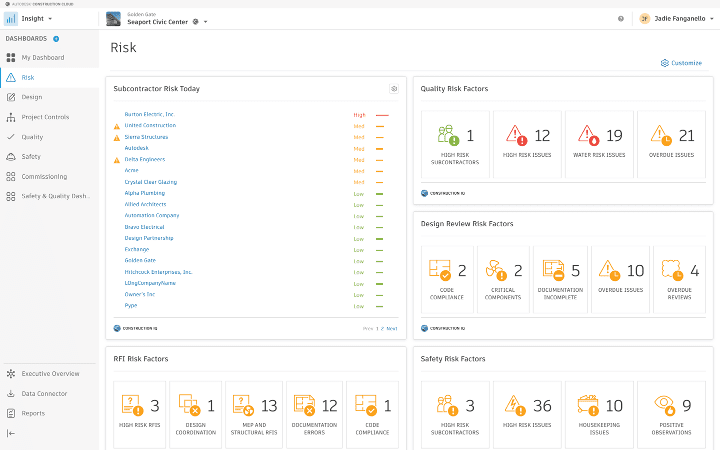
We spoke with Michael Murphy, Digital Construction Operations Manager at BAM Ireland, to understand how Construction IQ is helping to drive safer, higher-quality projects for its teams with less risk. Here are some great examples of how Construction IQ can specifically help teams across various workflows:
Driving Better Safety Oversight
One of the most important goals on a jobsite is to ensure everyone goes home safely at the end of each day. Safety management is by no means a new concept. But with Construction IQ, teams can spend more time looking into leading indicators that can predict and reduce safety issues rather than responding to lagging incidents.
For example, 60% of all construction related deaths are attributed to accidents occurring within one of the “fatal four” categories; fall, caught in between, electric, and struck by. Construction IQ uses its machine learning technology to categorize jobsite issues that fall into these categories so that teams can quickly see, prioritize, and address the most pressing issues.
“Construction IQ gives us laser sharp focus in terms of the health and safety issues onsite, enabling our teams to focus and track leading safety indicators, whilst working with our supply chain partners more effectively,” says Murphy. “By visualising safety issues such as high-risk subcontractors or high-risk safety items, we can address issues right away, resulting in a heightened level of safety on-site.”
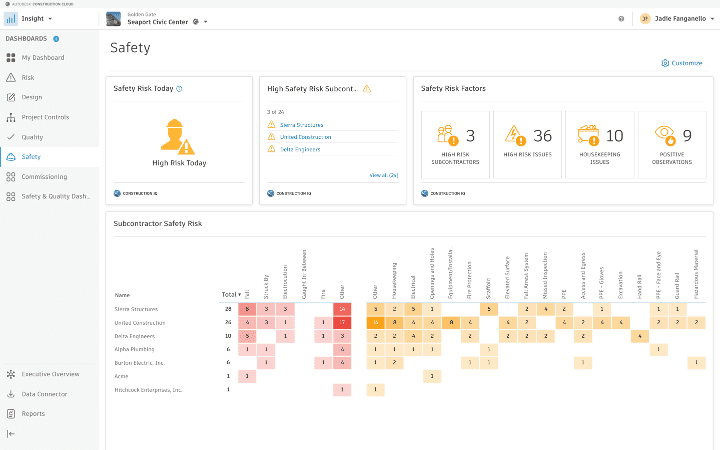
Improving Project Quality
Keeping track and maintaining project quality is another critical part of a successful project. But it’s challenging for teams to understanding where to focus attention to address these issues.
Through the Quality Risk Factor card in both the Autodesk Construction Cloud platform and BIM 360, you can easily see a list of high risk subcontractors and issues predicted by Construction IQ. These could have been tagged if there was some indication of rework, inspection risk, or water related risk as water infiltration can be a primary cause of high-risk quality issues as construction progresses.
“Construction IQ surfaces all of the leading quality-related trends that support our teams in focusing on helping our partners succeed in their execution,” says Murphy. “By flagging an issue that poses high risk earlier in the process, we can eliminate any issues before it significantly impacts the quality of the project.”
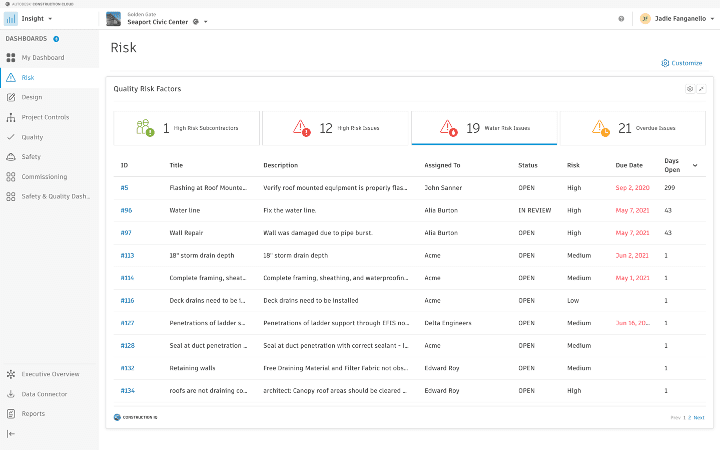
Reducing Design Risk
Through internal research, we found out that over 70% of RFIs stem from design or documentation issues. Diving a bit deeper, unsuccessful projects (classified by profit margins) tend to have 50% more RFIs, with a root cause in Design & Engineering or documentation issues, than successful projects. It is critical to resolve these design issues as early as possible, so they don’t become higher cost impact RFIs later during construction.
With the Design Risk Factor card, you can see design specific risk such as code compliance issues, issues to critical building components, and errors and omissions in design and documentation.
“The Design Risk Factor card provides insight into design issue trending, which enables our design teams to concentrate on areas of the design that are on our critical path,” says Murphy. “By identifying design issues earlier in the process, we can avoid any necessary cost overruns or schedule delays.”
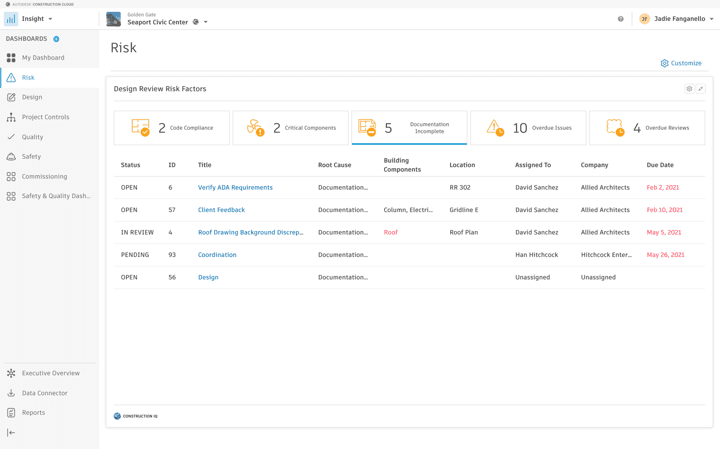
Enhancing Project Controls with RFI Management
Teams often struggle in prioritizing which RFIs to focus on. This can frequently lead to additional rework, schedule delays, and cost overruns. Furthermore, design and construction information are often disconnected, increasing the total number of RFIs in general.
Our data experts found that projects that prioritized closing more critical RFIs faster were more successful. So how can teams better prioritize and manage RFIs?
The Construction IQ driven RFI Risk Factor card breaks down RFIs based on those tagged as higher risk, any MEP or Structural RFIs, RFIs that have a root cause in design coordination, documentation errors, or code compliance since these tend to drive the most cost or schedule related impact.
“Construction IQ provides critical insight into the status and progress of RFI’s on which to prioritise by level of risk,” says Murphy. “This reduces the level of effort normally required by us to manage this process on a daily basis, allowing us to focus on other critical areas of the project.”
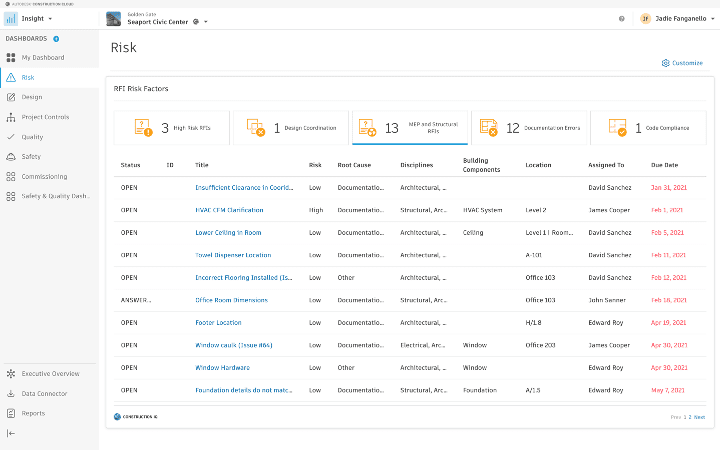
Leverage the Power of Machine Learning for Your Projects Today
Harness the power of Construction IQ’s built-in machine learning and AI functionality to predict, prevent and manage risks to cost, schedule, quality, and safety. Learn more here.
We recently spoke to two industry experts on the future of AI and machine learning in construction on our Digital Builder podcast. Listen to the full episode here.
The post Leverage Machine Learning to Reduce Risk with Construction IQ appeared first on Digital Builder.
Issue Resolution and Clash Avoidance with Autodesk BIM Collaborate
Construction management is a highly complex and multi-dimensional collaborative effort. To execute on projects effectively, several people and moving parts all need to click and stay in sync. Issues need to be resolved quickly, questions must be answered in a timely manner, and there should be trust and accountability across the entire team.
Accomplishing all that, however, is easier said than done.
Design and construction teams struggle to find a seamless way to identify issues and circulate them to the appropriate stakeholders. Often, teams rely on spreadsheets, static reports, or third-party management solutions to gather information and make decisions.
Unfortunately, these tools and sources are unreliable and inaccessible to the wider team. They cause confusion and are ultimately ineffective for detecting clashes and resolving issues. Not to mention, the manual tasks involved with static documents and spreadsheets are tedious, time consuming, and can cause issues to slip through the cracks.
The result? Issues that could’ve been avoided bubble up to the surface later on in the form of rework — and unnecessary costs. Clashes alone account for 5% of construction spend and 52% of the $280 billion of annual rework costs are caused by poor project data and communication globally.
To address this, many companies turn to third-party point solutions to address specific problems. However, these programs usually require further training and implementation, as well as additional costs.
To make matters more complicated, the different parties involved (e.g., design firms, GCs, and subcontractors) all use different systems and platforms. The JBKnowledge 2020 ConTech report found that 63% of construction pros are using three to six more apps — which makes integration and communication harder and limits project data usage.
All this to say that managing project issues in construction can be a headache.
What if you could address issues at the same time and at the same place, to streamline resolution?
The combination of Autodesk BIM Collaborate (part of the Autodesk Construction Cloud platform), Navisworks, and Revit makes all that possible.
Thanks to the tight integration between these solutions, issues can be created, managed, or resolved directly in the tools you work in daily, and are connected using a common data environment (CDE).
By surfacing and resolving issues in a CDE, you create a lasting history of decisions made for downstream stakeholders for future reference. It also allows multidisciplinary teams with different tools to manage and communicate about issues using a common solution.
All in all, this paves the way for a roundtrip workflow, which helps teams close the loop with any clashes or issues that arise.
Issues created in either Autodesk BIM Collaborate or Navisworks can be assigned and contextualized in either of those tools and resolved in Revit. That resolution then makes its way back to Autodesk BIM Collaborate for reporting and future project forecasting.
Let’s take a look at just one of the ways all these solutions work together.
Autodesk BIM Collaborate
Autodesk BIM Collaborate’s browser-based model coordination and design collaboration tool comes with automatic clash detection and grouping tools that help identify issues early on. The software’s UI is intuitive and easy on the eyes, so all discipline types (designers, GCs, and specialty contractors) can use the solution.
Team members can self-check their work as they go, and if issues come up, they can flag it with a location pin and add details such as the root cause, description, important dates, and clash screenshot. From there, they can assign the issue to the appropriate stakeholder.
Because multiple stakeholders can take part in identifying and assigning issue tasks, the coordination process is faster and much more streamlined. Issues and their associated models are stored in a common data environment for multi-team, product, and construction phase access to action on.
Navisworks Coordination Issues Add-In (Navisworks 2021-2022)
This Navisworks add-in connects models, views, and issues through a CDE, so BIM/VDC managers can easily create, track, assign, and resolve issues directly in their desktop application.
If a Navisworks user is unsure about an issue, they can simply comment directly within the platform. Similar to Autodesk BIM Collaborate, users can add issues and include details like type, location, assignee, description, and due date. They can then pair that issue with an image snapshot of the clash identified. Thanks to this add-in, stakeholders using the software can better contextualize the issue, resolve it, or assign it to someone else.
Navisworks also has an updated Coordination Space and Append capabilities. With the upgraded issues add-in, users now have the ability to append additional models from a Model Coordination space to their already opened set of models. This increases the efficiency of coordination meetings by allowing users to immediately update your .nwf files as new model files arrive from project design teams.
Plus, this free add-in seamlessly connects with Autodesk BIM Collaborate and Revit, so there’s no need for third-party integrations. You’ll reduce manual work and miscommunication, and resolve issues more quickly.
See for yourself by downloading and installing this add-in from the Autodesk App Store. Once installed, start Navisworks and navigate to the Coordination tab.
Revit Issues Add-in (Revit 2020 or later)
Using the very same common data environment and issues layer, architects and engineers working in Revit can scan through all the details we covered above and any additional information from the comments/history, to resolve the issue directly in the model.
This type of connectivity displays the same information to the entire project team, thus enabling stakeholders to literally stay on the same (digital) page. Stakeholders benefit from having more transparency and greater levels of accountability which result in less rework from issues slipping through the cracks.
Instead of waiting until the next coordination meeting to resolve an issue, users can continuously collaborate on models, speeding up time-to-site and reducing the expensive design iterations that occur from poor and sporadic communication.
You access this add-in from the Autodesk Desktop App or your Autodesk account. Get more info on how to use it from the Autodesk Knowledge Network.
Bringing It All Together
Autodesk BIM Collaborate, along with the Navisworks and Revit add-ins, take issue management to a whole new level.
These tightly integrated tools don’t just let you track or manage issues, they create an environment to collaborate and resolve them.
Issue resolution is tracked in Autodesk BIM Collaborate with a dashboard of outstanding issues and resolution overtime, paving the way for better management and prediction for future projects.
Plus, the entire project team can work together to resolve issues and collaborate with a “clash avoidance” mindset (as opposed to a “clash detection” mindset). This speeds up the time-to-site and reduces costly rework.
With a roundtrip workflow, issues are created in either Autodesk Construction Cloud or Navisworks, and actionable in Autodesk BIM Collaborate, Revit, or Navisworks, bringing the best of each environment to your next project.
Interested in experiencing Autodesk BIM Collaborate for yourself? Request a trial today.
Request a Trial
The post Issue Resolution and Clash Avoidance with Autodesk BIM Collaborate appeared first on Digital Builder.
Digital Transformation is Helping the Construction Industry Future-proof Their Businesses as They Recover from the Pandemic
Construction companies across Asia Pacific including Japan (APIJ) in the “acceleration” phase of recovery are most advanced at using technology to future-proof their businesses, the latest research has found.
A recent IDC InfoBrief, sponsored by Autodesk, Road to Recovery: Overcoming COVID-19’s Impact on the Construction Industry with Digital Technologies, surveyed the construction industry across the region and identified three stages of COVID-19 recovery: “response”, “adaptation”, and “acceleration”.
Throughout the COVID-19 crisis, 95% of construction companies have increased their adoption of digital technologies to drive digitalisation and become resilient. Across the industry, 89% of APIJ construction companies have seen an upsurge of solutions such as BIM workflows, bid management, project management and insights as a result of COVID-19 – but there is still a way to go.
Luckily, there is a tremendous opportunity for change. The InfoBrief states that before the pandemic, 80% of construction companies in the region were in the earliest stages of digital transformation (DX). This translated into short term, tactical and disconnected responses when the pandemic started. These companies have the biggest opportunity for change and to learn from their peers who are further along the road to recovery and in the acceleration phase.
Significant opportunity to increase adoption of digital solutions to support recovery
The opportunities to increase adoption of digital technologies to support businesses to thrive are in ample supply. Across the region, 46% of construction companies still leverage paper drawings for their projects, and 35% are considering purchasing a software solution to address this. Furthermore, when it comes to digital solutions 46% of companies ranked themselves as very knowledgeable in the handover phase of construction, but this was not the case in the design, planning or building phases where digital solution knowledge was ranked as low.
Almost 30% of ANZ survey respondents indicated they are now in the acceleration phase, closely followed by Japan-based respondents at 20%. Both of these countries are historically early adopters of technology so the results were not surprising. Looking forward to their next moves, the survey found that the top construction phases for planned investments are design and development for both ANZ and Japan; followed by the testing and comissioning phase.
Construction companies must embrace digital to survive and thrive
Because there is no clear indication of when the COVID-19 pandemic will end, construction companies must embrace the changes and opportunities that surround them. In particular, companies need to ensure the health and safety of their employees — and a safe working environment is a digital environment.
To create further resiliency in the “next normal” and to capture market share, construction companies in the acceleration phase should prepare for future growth opportunities with the use of digital construction solutions. The increased adoption of these technologies (for example, BIM) to support all construction workflows should be targeted investments that will support companies’ recovery and future growth.
Software such as the solutions within Autodesk Construction Cloud, an integrated cloud-based portfolio of products used to manage construction projects, enables connected workflows, teams and data at every stage of construction to reduce risk, maximise efficiency and increase profits.
With the construction industry facing a new era of convergence and evolving challenges for processes and teams, innovation is essential to create streamlined workflows and maintain competitiveness in today’s marketplace.
Find out more about the construction industry’s recovery, and the next steps you can take
For more information on the construction industry’s recovery and innovation since the pandemic began, view our previous blogs on how the industry is building resilience and future-proofing through digital technologies, how construction companies in the “response” phase of COVID-19 are using technology to ensure the workforce is connected, engaged and safe, and how construction companies in “adaptation” phase are using technology to support a hybrid workforce.
To download the IDC InfoBrief, click here. To find out more about how Autodesk Construction Cloud can support your business, contact us or get your free trial.
The post Digital Transformation is Helping the Construction Industry Future-proof Their Businesses as They Recover from the Pandemic appeared first on Digital Builder.